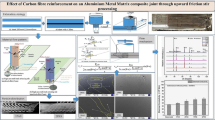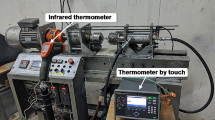Abstract
Aim of this study is to investigate the interface morphology and joint configuration of dissimilar thickness aluminium alloy 5052-H32 sheets during friction stir spot welding. The investigation begins with the optimization of two important process parameters, viz. tool rpm and dwell time, from welding of similar thickness sheets. Further, different combinations of sheet thicknesses were welded using the optimized parameters. Effect of altering sheet thickness on the mechanical and structural properties were compared with welds of similar sheet thickness. For similar thickness welds, maximum failure load of 4020 N was noted at minimum tool rotational speed of 450 rpm and maximum dwell time of 8 s. The obtained weld zones revealed the presence of hook which was found to vary in its pattern and location for different combinations of sheet thicknesses. Minimum hardness of 63 HV was obtained in the periphery of the thermo-mechanically affected zone and heat-affected zone. In addition, welds with thinner top sheets showed higher load-bearing capacity and wider bonded area as compared to thicker and equal thickness top sheet welds. The maximum failure load of 7160 N was obtained for 1.5 and 2.5-mm-thick top and bottom sheets, respectively. Moreover, three fracture modes were observed in tensile/shear tests, namely interfacial, circumferential and nugget pullout fracture mode. Samples which failed in circumferential and nugget pullout fracture mode showed better joint strength.












Similar content being viewed by others
References
Shanavas S, Edwin Raja Dhas J (2017) Parametric optimization of friction stir welding parameters of marine grade aluminium alloy using response surface methodology. Trans Nonf Met Soc China 27(11):2334–2344
Han L, Thornton M, Shergold M (2010) A comparison of the mechanical behaviour of self-piercing riveted and resistance spot welded aluminium sheets for the automotive industry. Mater Des 31(3):1457–1467
Sun HT, Lai XM, Zhang YS, Shen J (2007) Effect of variable electrode force on weld quality in resistance spot welding. Sci Technol Weld Joi 12(8):718–724
Briskham P, Blundell N, Han L, Hewitt R, Young K, Boomer D (2006) Comparison of self-pierce riveting, resistance spot welding and spot friction joining for aluminium automotive sheet. SAE technical paper (no. 2006-01-0774)
Uematsu Y, Tokaji K (2009) Comparison of fatigue behaviour between resistance spot and friction stir spot welded aluminium alloy sheets. Sci Technol Weld Joining 14(1):62–71
Malafaia AMS, Milan MT, Oliveira MF, Spinelli D (2010) Fatigue behavior of friction stir spot welding and riveted joints in an Al alloy. Procedia Engineering 2(1):1815–1821
Pieta G, Dos Santos J, Strohaecker TR, Clarke T (2014) Optimization of friction spot welding process parameters for AA2198-T8 sheets. Mater Manuf Processes 29(8):934–940
Zhang Z, Yang X, Zhang J, Zhou G, Xu Xand Zou B (2011) Effect of welding parameters on microstructure and mechanical properties of friction stir spot welded 5052 aluminum alloy. Mater Des 32(8):4461–4470
Shen Z, Yang X, Zhang Z, Cui L, Yin Y (2013) Mechanical properties and failure mechanisms of friction stir spot welds of AA 6061-T4 sheets. Mater Des 49:181–191
Badarinarayan H, Yang Q, Zhu S (2009) Effect of tool geometry on static strength of friction stir spot-welded aluminum alloy. Int J Mach Tools Manuf 49(2):142–148
Tozaki Y, Uematsu Y, Tokaji K (2007) Effect of processing parameters on static strength of dissimilar friction stir spot welds between different aluminium alloys. Fatigue Fract Eng Mater Struct 30(2):143–148
Freeney TA, Sharma SR and Mishra RS (2006) Effect of welding parameters on properties of 5052 Al friction stir spot welds. SAE technical paper (no. 2006-01-0969)
Garg A, Bhattacharya A (2017) On lap shear strength of friction stir spot welded AA6061 alloy. J Manuf Process 26:203–215
Suresh VS, Regalla SP, Gupta AK (2017) Combined effect of thickness ratio and selective heating on weld line movement in stamped tailor-welded blanks. Mater Manuf Process 32(12):1363–1367
Vilaça P, Santos JP, Góis A, Quintino L (2005) Joining aluminium alloys dissimilar in thickness by friction stir welding and fusion processes. Weld World 49(3–4):56–62
Lee CY, Lee WB, Kim JW, Choi DH, Yeon YM, Jung SB (2008) Lap joint properties of FSWed dissimilar formed 5052 Al and 6061 Al alloys with different thickness. J Mater Sci 43(9):3296–3304
Darwish SM, Al-Samhan AM (2004) Peel and shear strength of spot-welded and weld-bonded dissimilar thickness joints. J Mater Process Technol 147(1):51–59
Yoon S-O, Kang M-S et al (2012) Influences of tool plunge speed and tool plunge depth on friction spot joining of AA5454-O aluminum alloy plates with different thicknesses. Trans Nonferrous Met Soc China 22:S629–S633
Tran VX, Pan J, Pan T (2009) Effects of processing time on strengths and failure modes of dissimilar spot friction welds between aluminum 5754-O and 7075-T6 sheets. J Mater Process Technol 209(8):3724–3739
ISO 14273. (2000) Specimen dimensions and procedure for shear testing resistance spot, seam and embossed projection welds. International Organization for Standardization, Geneva, Switzerland.
ASTM E8/E8 M-15a (2015) Standard test methods for tension testing of metallic materials. ASTM International, West Conshohocken, PA
Rosendo T, Parra B, Tier MAD et al (2011) Mechanical and microstructural investigation of friction spot welded AA6181-T4 aluminium alloy. Mater Des 32(3):1094–1100
Cao JY, Wang M, Kong L, Guo LJ (2016) Hook formation and mechanical properties of friction spot welding in alloy 6061-T6. J Mater Process Technol 230:254–262
Zhang GF, Wei SU, Zhang J, Wei ZX, Zhang JX (2010) Effects of shoulder on interfacial bonding during friction stir lap welding of aluminum thin sheets using tool without pin. Trans Nonferrous Met Soc China 20(12):2223–2228
Salari E, Jahazi M, Khodabandeh A, Ghasemi-Nanesa H (2014) Influence of tool geometry and rotational speed on mechanical properties and defect formation in friction stir lap welded 5456 aluminum alloy sheets. Mater Des 58:381–389
Badarinarayan H, Shi Y, Li X, Okamoto K (2009) Effect of tool geometry on hook formation and static strength of friction stir spot welded aluminum 5754-O sheets. Int J Mach Tools Manuf 49(11):814–823
Lathabai S, Painter MJ, Cantin GMD, Tyagi VK (2006) Friction spot joining of an extruded Al–Mg–Si alloy. Scr Mater 55(10):899–902
Paidar M, Khodabandeh A, Sarab ML, Taheri M (2015) Effect of welding parameters (plunge depths of shoulder, pin geometry, and tool rpm) on the failure mode and stir zone characteristics of friction stir spot welded aluminum 2024-T3 sheets. J Mech Sci Technol 29(11):4639–4644
Tutar M, Aydin H, Yuce C, Yavuz N, Bayram A (2014) The optimisation of process parameters for friction stir spot-welded AA3003-H12 aluminium alloy using a Taguchi orthogonal array. Mater Des 63:789–797
Bozzi S, Helbert-Etter AL, Baudin T, Klosek V, Kerbiguet JG, Criqui B (2010) Influence of FSSW parameters on fracture mechanisms of 5182 aluminium welds. J Mater Process Technol 210(11):1429–1435
Ilangovan M, Boopathy SR, Balasubramanian V (2015) Microstructure and tensile properties of friction stir welded dissimilar AA6061–AA5086 aluminium alloy joints. Trans Nonferrous Met Soc China 25(4):1080–1090
Bozkurt Y, Salman S, Cam G (2013) Effect of welding parameters on lap shear tensile properties of dissimilar friction stir spot welded AA 5754-H22/2024-T3 joints. Sci Technol Weld Join 18(4):337–345
Yuan W, Mishra RS, Webb S, Chen YL, Carlson B, Herling DR, Grant GJ (2011) Effect of tool design and process parameters on properties of Al alloy 6016 friction stir spot welds. J Mater Process Technol 211(6):972–977
Hall E (1954) Variation of hardness of metals with grain size. Nature 173:948–949
Piccini JM, Svoboda HG (2015) Effect of pin length on Friction stir spot welding (FSSW) of dissimilar aluminum-steel joints. Proc Mater Sci 9:504–513
Rodrigues DM, Loureiro A, Leitao C, Leal RM, Chaparro BM, Vilaça P (2009) Influence of friction stir welding parameters on the microstructural and mechanical properties of AA 6016-T4 thin welds. Mater Des 30(6):1913–1921
Yong Y, Zhang DT, Cheng QIU, Zhang W (2010) Dissimilar friction stir welding between 5052 aluminum alloy and AZ31 magnesium alloy. Trans Nonferrous Met Soc China 20:619–623
Chen HB, Wang JF, Zhen GD, Chen SB, Lin T (2015) Effects of initial oxide on microstructural and mechanical properties of friction stir welded AA2219 alloy. Mater Des 86:49–54
Jeon C-S, Hong S-T, Kwon Y-J, Cho H-H, Han HN (2012) Material properties of friction stir spot welded joints of dissimilar aluminum alloys. Trans Nonferrous Met Soc China 22:605–613
Cox CD, Gibson BT, Strauss AM, Cook GE (2012) Effect of pin length and rotation rate on the tensile strength of a friction stir spot-welded al alloy: a contribution to automated production. Mater Manuf Process 27(4):472–478
Bisadi H, Tavakoli A, Sangsaraki MT, Sangsaraki KT (2013) The influences of rotational and welding speeds on microstructures and mechanical properties of friction stir welded Al5083 and commercially pure copper sheets lap joints. Mater Des 43:80–88
Acknowledgements
The authors are thankful to the Director, CSIR-NML Jamshedpur and Tata Steel R&D for their support in conducting this research work.
Author information
Authors and Affiliations
Corresponding author
Additional information
Technical Editor: Lincoln Cardoso Brandao.
Publisher's Note
Springer Nature remains neutral with regard to jurisdictional claims in published maps and institutional affiliations.
Rights and permissions
About this article
Cite this article
Kumar, A., Arora, K.S., Gupta, R.K. et al. Investigation on interface morphology and joint configuration of dissimilar sheet thickness FSSW of marine grade Al alloy. J Braz. Soc. Mech. Sci. Eng. 41, 381 (2019). https://doi.org/10.1007/s40430-019-1882-9
Received:
Accepted:
Published:
DOI: https://doi.org/10.1007/s40430-019-1882-9




